Searching for Florida’s lost seagrape jelly recipe

Illustration by Jade Le
December 16, 2021 | Story by Marlowe Starling
As summer days grew long, Darriel Patrick would trot down a dirt path leading to the sea, her blonde tresses bobbing against her round face. She grew up in the 1950s, when grocery stores and water sports were not commonplace in the rural Florida Keys. Back then, it was a barren strip of land.
Seagrapes have been an integral part of Florida’s landscape; the jelly made from them is a part of the state’s cultural history. But now, seagrape jelly faces an existential crisis, preserved only on the yellowed pages of cookbooks and in the memories of aging Floridians.
With a sister eight years her senior and few friends nearby, slow afternoons on an island could get boring for a young girl. So, Darriel, who I know as Nana, went searching for a favorite snack that came around only once a year: seagrapes.
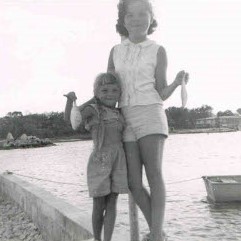
A young Darriel Patrick, left, holds a fish next to her older sister, Gail Wilson. Darriel has fond memories of eating seagrape jelly as a child, although it’s unclear if her mother, Mary, ever made it from scratch. (Photo courtesy of Marlowe Starling)
Along the water, there were plenty. Stalks of seagrape were as ubiquitous in mid-20th century Monroe County as tourists are today. Sea-seeking snowbirds now come in droves to this place that my family used to call home, a place now commercialized by cartoon parrots and round-the-clock rum slushies. Admittedly, this is the Keys I’ve always known. I grew up with Jimmy Buffet tunes and enjoyed the occasional day trip from Miami to Islamorada for a relaxing afternoon getaway.
That’s not the place my Nana knew. The real Keys were rural. Remote. And, as Darriel will tell you, uneventful. Now that it’s gone, Darriel, 72, treasures the simplicity of her ribbon of land: a highway with the ocean lapping on each side of it and not much else. She grew up an island girl, running barefoot across the rocky shore, hardly phased by the sharp edges and rough textures of Florida’s exposed karst. She grew up tough. In the Keys, almost everyone did. But balancing that roughness was always the tender, tart-sweet delight of the seagrape fruit. When the stalks began to sprout clusters of round, bright-green buds, young Darriel knew the time was near. Soon, they would ripen to a rich purple, ready to eat. She plucked seagrapes to sneak a snack, the tropical version of blueberry picking. She let the sticky juice dribble down her cheeks and chin as she gobbled away, the squirrels and birds salvaging whatever fell to the ground. Inside the mobile home in which she and her sister were raised, there was more to be had. On the kitchen counter sat a jar of seagrape jelly.

I hadn’t heard of seagrape jelly until my mother reminisced about enjoying it during the cicada-swarmed weekends she spent in the Keys with her grandmother and namesake, Mary Patrick. What does that taste like, I wondered? My mother couldn’t remember. She had a recipe bookmarked in an old cookbook — but the cookbook wasn’t easy to find, either. I set off to find the answers my family didn’t have.
To me, Mary was Great Nanny. To Darriel, she was Mom. And to many others who knew her, she was the redheaded queen of Plantation Key.
Freckled, bold and marvelous, Mary caused heads to turn: You could smell a whiff of confidence as she walked down the street, her head of fire held high. She worked tirelessly to provide for her two daughters, even after her husband was killed on U.S. Highway 1 on his way to work. Crying was only allowed if you wiped your tears immediately and picked yourself back up — even if it meant swallowing your pride to make your kids peanut butter and jelly sandwiches for dinner again. Even if it meant Darriel and her older sister, my great aunt Gail, only owned two pairs of shoes: one for summer, the other for winter. With less than a high school diploma, Mary built a mobile home empire.
The seagrape, much like Mary and much like lifelong Floridians, is a hardy specimen. It likes a lot of sunshine and prefers its real estate on the coast. It has a high tolerance to salt and drought. Nothing stands in the way of this woody tree that hugs the coast of Florida, weathering the winds on beaches and sheltering shorebirds from stormy weather. Its broad leaves are thick enough to block the midday sun, a natural umbrella for coast-dwelling critters. They also shield helpless sea turtle hatchlings from the lure of human light, which they often confuse for the moon’s glow that guides them toward the ocean. Seagrapes even provide sanctuary for the Florida reef gecko, an endangered lizard that could easily snuggle up in the crease of an index finger. And the plant’s delicate white flowers seduce pollinators, making for a deliciously floral honey. (I keep a small jar in my pantry.)
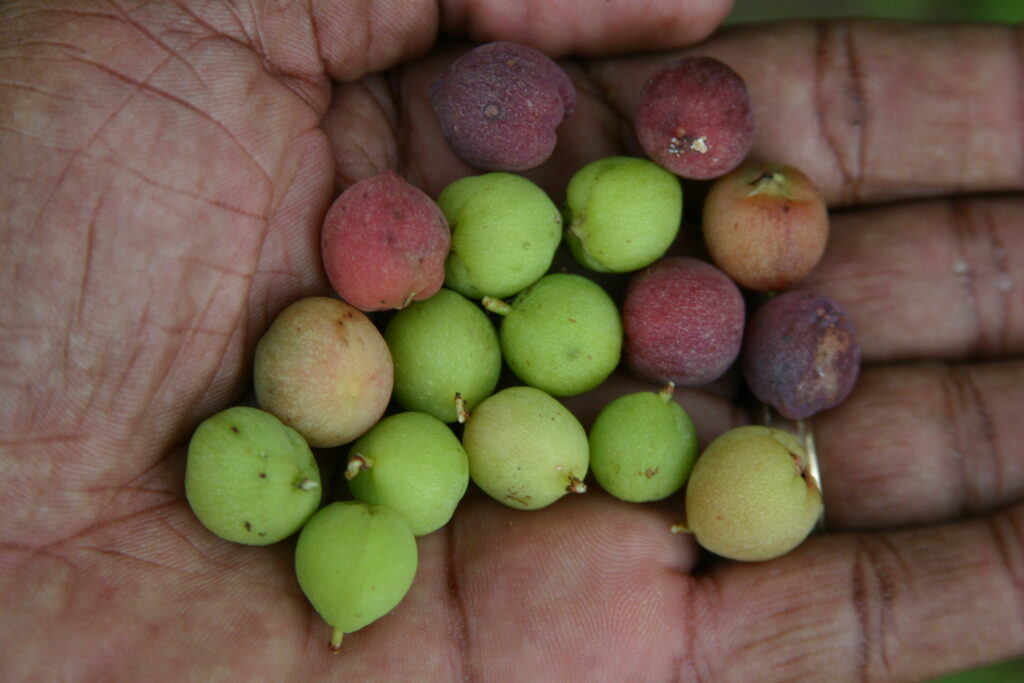
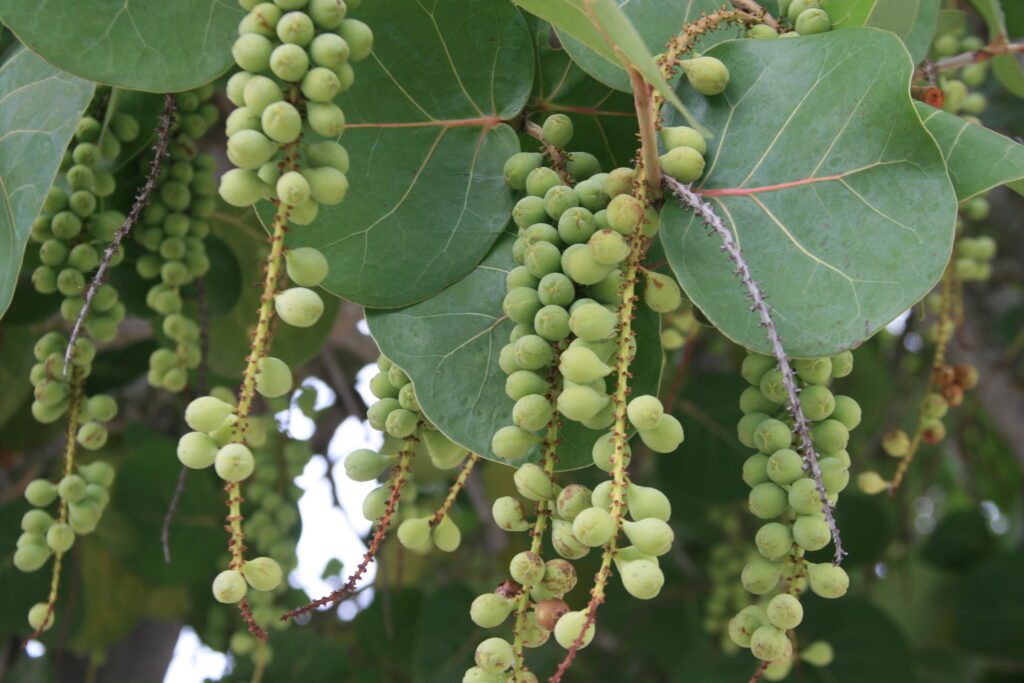
Seagrapes grow in clusters, but they ripen individually from a bright green to a deep purple when they’re ready to eat. (Photos courtesy of Stephen H. Brown)
For centuries, seagrapes served as a multipurpose tool for the people who called South Florida home. Records show that Tequesta and Calusa natives used seagrapes for virtually everything from nourishment to medicinal cures. They used the fruit for food, and the bark and roots to treat digestive ails. Scholars believe the Spaniards later made use of seagrapes as well by pinning the leaves together to use as writing paper.
In recent decades, Floridians have still appreciated all the plant has to offer. In a 1980 book about native landscape plants in South Florida, author Richard Workman wrote that the “leathery” leaves can be used for plates at picnics or “as a strange but useful hat” when pinned together. Dried leaves could be used as gift tags or paper, the wood for making cabinets. “It is no wonder then,” Workman concluded, “that the seagrape is so widely appreciated.”
Perhaps that was once true. But today, so few venture outside to pluck seagrapes — as my grandmother once did — that many Floridians don’t even know they are edible. Instead, the seagrape’s popularity is now largely confined to landscaping. Several counties have ordinances requiring homeowners to plant only native species, and the seagrape is one of them. Yet, as Lee County horticulture agent Stephen H. Brown explained to me, some homeowners lament the mess they make when they shed their broad leaves in the spring, adding a layer of litter on their well-manicured lawns.
Climate change is driving plenty of Florida’s environmental shifts, but the demise of the seagrape’s utility has more to do with cultural change. The fruits still ripen, and seagrape’s fanlike leaves can be seen anywhere in coastal South Florida. But practically speaking, the fruits spoil quickly and aren’t easy to eat, no thanks to the small pit in the center. I’ve yet to meet a child who plucks the berries off the stems during the short window of time in which they ripen, like my grandmother once did. Seagrapes now have less practical appeal than they do nostalgia for a generation that remembers a time when home remedies and homemade jams were more common.
But when Mary was the redheaded queen of Plantation Key, seagrapes were very much a part of local lives. The ruby red jelly that women made in their kitchens took hours of labor. And it was a delicacy of the area, hallowed in cookbooks and newspaper articles. Many boasted of family recipes passed on from one generation to the next.
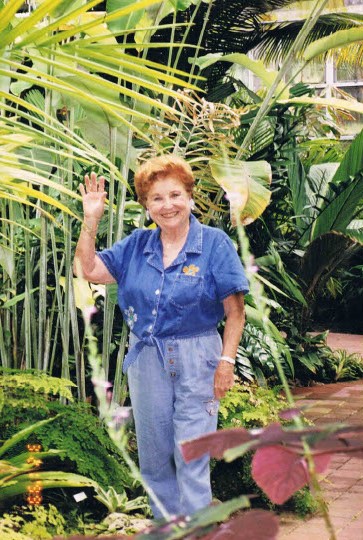
Mary Patrick, the author’s great-grandmother, raised her children in the Florida Keys when seagrape jelly was more popular than it is today. (Photo courtesy of Marlowe Starling)
This legacy made me wonder why it hadn’t stuck around in my own. The recipe is somewhat akin to myth for my family. Nobody knows how to make it, and few remember the taste. If Great Nanny had in fact made seagrape jelly, she certainly didn’t pass a recipe down to my grandmother or my mother. Mary was a busy woman; Darriel can’t quite remember her mother making jelly. But my mother thinks she remembers Great Nanny making the jelly one time. She spent quiet weekends in the Keys with Great Nanny as a little girl — just granddaughter and grandmother alone time.
Darriel isn’t convinced. “I never, ever remembered her making it,” she said, though she knows one thing for sure. She could usually find some in the kitchen.
I thought of the jar of seagrape jelly that Darriel remembers sitting on the kitchen counter. I didn’t want my pursuit of it to end just because no one in my family could make it. So, I went in search of someone who did.

Seagrape jelly is more of a memory now, a remnant of the past, like a line of algal residue on the dockside during low tide. So much so that Claudia Clark hasn’t tried making it in 20 years.
Clark, six years older than Darriel, knew the merits of hard work from a young age. She, like Mary, is a hard-edged Florida Keys woman, born and raised in Islamorada. She went to the same K-12 school, Coral Shores, that Darriel and her sister attended. The Keys were a more intimate place then. Everyone knew everyone.
Clark has a memory of gold and a keen sense of reality. She recalls The Trading Post, the grocery store that’s been around since 1966 and sits at mile marker 81.5 in Islamorada, not far from where Darriel grew up.
“You went grocery shopping there, if you could afford it,” Clark said.
If I wanted to taste seagrape jelly, I could probably buy a jar there, she told me. Eager to find a jar after so many months, I called the store to ask.
My heart sank when I heard the answer.
“It’s really just something a few older people make around the holidays. Sorry,” the man on the other end said.
Disappointed, I thanked him, but it confirmed my fears. Seagrape jelly is a thing of the past — and it might just disappear, like it did in my family, unless the last remaining jelly-makers pass it down to their heirs.

Darriel’s Florida Keys would be unrecognizable to today’s casual tourist. She grew up on an ISLAND — “in all caps,” she says. And that’s just what it was: hot, buggy, remote and slow-paced. People married young to get out. But those who did — those like my grandmother — miss it upon looking back. The hard thing to accept is that her generation of Keys kids will never return to the same ribbon of land they left so many years ago. The old Keys is gone.
Well, not entirely. You can still find it in the sweet tanginess of seagrape jelly. It’s a jam as versatile as it is unique: a tart spread for your morning toast, afternoon biscuit or evening tea and crackers.
Last spring, Clark sent me two photocopies of a typewritten document. On the bottom:
Prepared and distributed by the Monroe County Office of the Florida Cooperative Extension Service
P.O. Box 2545, Key West, FL 33040
On the top, in Old English font:
Sea-Grape
It reveals that at one time, seagrapes played a larger culinary role than just jelly. Listed and underlined are several recipes:
PREPARING SEA GRAPE JUICE
SEA GRAPE JUICE DRINK
SEA GRAPE JELLY
SEA GRAPE JELLY (using pectin)
SEA GRAPE SOUP
Seagrape soup? Apparently, yes.
“In a large saucepan, combine 3 cups sea grapes, pitted, with 4 cups beef consommé. Bring the mixture to a boil and simmer until the fruit is tender. Liquify fruit in blender. Add salt and pepper to taste. Chill until cold. Serve in chilled soup cups. One tablespoon light rum can be added, if desired.”
Not only is this a cold soup, but it’s a boozy one, too. I grinned, knowing Great Nanny would approve. How could I expect anything less from the Monroe County archives?

The rum-optional seagrape soup recipe is fit for a South Florida king. Roger Hammer fit that bill.
As South Florida’s premiere naturalist, a storied author, and an untrained botanist, Hammer talks about seagrapes like an old buddy.
“Growing up as a budding young surfer in Cocoa Beach, I fondly remember seagrapes, saw palmettos, and sea oats lining the upper dunes as far as one could see, where you could walk down the beach for miles and see very few houses,” he said in an email.
“I remember eating seagrapes, and our mom making seagrape jelly. There was even seagrape jelly sold in local roadside fruit stands, as well as seagrape honey. I’ve also heard of seagrape wine, plus a dram made by soaking seagrape fruits in vodka, similar to what they do with allspice fruits.”
His colloquial passages reveal a Florida upbringing not too different from my grandmother’s, finding entertainment in spending hours outdoors. Hammer goes for 200-plus-mile solo kayaking paddles with just a fishing rod in his Kaskazi kayak, custom made in Cape Town, South Africa. Out on the water, he trusts in his faithful Boone Castana lure to reel in redfish, snook and maybe a tarpon off a South Florida coast lined with high-rises and oceanfront mansions.
His tough-guy persona on Biscayne Bay’s turbulent waters is balanced with a deep appreciation for Florida’s delicate flora. Florida International University awarded him an honorary Doctor of Science degree just to prove it. But he doesn’t need any academic prestige to be South Florida’s expert source of information on native plants. An experienced nature guide, he set out to photograph more than 100 of Florida’s wild orchids.
Though best versed in Florida’s wildflowers, Hammer knows the importance of seagrapes. He grows a few in his backyard in Homestead, the agricultural and botanical mecca of South Florida. Fruit, landscape plants, bonsai trees, you name it. Out here, it’s a different kind of doldrums, one that smells of nutrient-rich soil and horse manure from the small ranches where I once learned how to ride. As you drive deeper into this place that’s known as the Redlands, roadside fruit stands abound and billboards advertise the Swamp Ape and alligator farms. It’s Florida, raw and rural.
Hammer told me he hates to see seagrapes trimmed as a hedge. Not only are the trees pretty, but careful woodwork can turn the strong wood into bowls, cups, spoons, and cutting boards tinted a rich red.
They’re both elements that would have appealed to my dad’s mom. Grammy had a 1-acre yard full of overflowing foliage. In the front yard was one of those oh-so-pretty seagrape trees. My dad, the youngest of five, remembers, with a boyish smirk, pelting the hard, unripened seagrapes at his siblings. Grammy’s yard was a tropical paradise, with all kinds of other marvels like starfruit. I ate them off the tree like Darriel used to eat seagrapes.
Grammy, born on the rustic Italian island of Sardinia, was also a passionate craftswoman. She sold her own wire-wrapped crystal jewelry, made into pendants and rings. She also, I discovered recently, tried her hand at woodwork. I wonder now if she ever carved into the seagrape’s textured bark, if she, too, lives on in the twisted trunks of the seagrape trees in my neighborhood.
But the seagrape tree in the front yard of my father’s childhood home, tucked on the corner of a quiet backstreet in Miami, isn’t there anymore. After the house was sold, both it and the seagrape tree were torn down.

Buoyed by the archival recipes and Hammer’s botanical knowledge, my quest went on to track down someone who makes the rumored seagrape jelly. I set out for the Randell Research Center, a history museum and archaeological site in Southwest Florida’s Pine Island. But the cultural knowledge I was looking for wasn’t housed in the museum.
As it happens, there’s a large seagrape tree next to the tiny post office nearby. A retired postmaster, Gina Poppell used to harvest the fruit to make seagrape jelly. Sometimes she would drop off a jar or two for the research center folks, they told me. This, I thought, was the woman I needed to talk to.
Poppell has lived in Pine Island for as long as she’s been married to her husband, but she traces her roots to the same strip of barren land where my grandmother was raised. As it happens, Poppell is a Florida Keys woman, too. But that’s not where she learned how to make seagrape jelly.
Poppell took it upon herself to learn her grandmother-in-law’s recipe for seagrape jelly — before it disappeared forever. Big Granny, as they called her, was the only one in the family who knew the recipe. They enjoyed it on buttered biscuits, a sweet treat for all to share.
Over the years, Poppell paid careful attention to how Big Granny made that tasty jam. It was a game of show-and-tell. Now, Poppell is the jelly master of the family, although she makes her own adjustments here and there. When her grandchildren were little, they asked for secret jelly. But Poppell knew, of course, that they meant “seagrape” jelly, although perhaps “secret jelly” is a more appropriate name. You could say the recipe is somewhat of a secret: She doesn’t have it written out, save for a few guiding notes scribbled in the back of one of her cookbooks.
She read bits and pieces of them to me over the phone, slowly, as though she were refreshing her memory.
“Wow, I haven’t done this in two years,” she said, with a chuckle. “It’s time to do it, obviously.”
When her kids and grandkids were younger, it was easier to coax them into picking seagrapes. Harvesting could take as little as an afternoon or as long as a few days, depending on the number of enlisted hands. Unlike other fruits that grow in bunches, seagrapes ripen individually, each on its own journey to becoming a plump, juicy bulb. Sometimes, Poppell picks them one by one. Other times, she lays a tarp on the ground beneath a tree she has permission to harvest and gives the branches a gentle shake. Only the ripe ones will fall. The best time to harvest, she said, is right before the storms come in late August and early September.
So begins a long, two-day process. Once she collects the fruit, she washes them thoroughly to make sure there are no bugs. As they sit in the Poppell kitchen, the fresh fruits fill the house with their aromas. Then, in a pot, she barely covers them with water, stirring them as they simmer to release the juice. Next comes the draining and straining, resulting in a mushy mixture. She plops it on a cheesecloth and gently squeezes it through. The harder you squeeze, the murkier the jelly. By the end of day one, you should have an “almost opaque purple liquid.”
Day two is when the real magic happens. Make sure you have everything laid out, Poppell warns, OK?
Bowls, sterilized jars, lids and rims, pots, four pounds of sugar (that’s 10 and a half cups), and no curious children or dogs to trip over. This is no recipe for the disorganized.
Once everything is set, she brings the juice from the previous day to a boil. She stirs in powdered Sure Jell pectin and brings the liquid to a boil again. Then she adds the sugar, all in one pour, and stirs, careful to leave enough room in the top of the pot to avoid messy boil-over spills. She lets it boil for a minute, stirring constantly with a wooden spoon.
Now for the taste test. There are several ways to test the jelly: One, by taking its temperature. If it hits 220 degrees Fahrenheit, it’s ready. Or, you can use the Big Granny method: Take a spoon, dip it in the jelly, and tip it. If the mixture sheets off the spoon in a clean line, it’s ready. Poppell remembers that Big Granny’s jelly was really thick and really good.
Once the jelly is done cooking, prepare to jar it up, carefully. If you’re lucky, you can use a funnel. If you’re luckier, you’ll have a sous-chef at your side to move the funnel — or a spoon — from jar to jar while you carefully pour the hot jelly into each one. Then, tighten the lids, and when you hear the ping, it’s vacuum sealed.
“Usually someone comes along to scrape the pot,” she said, like licking leftover icing or cake batter off the spoon.
Of her six granddaughters, two of them have an interest in making the recipe themselves. Of the two, there’s one who probably is most likely to carry on the tradition. “The eater,” Poppell said. Maybe she’s next in line to carry on the recipe. Or maybe it will be washed away by the waves of time, the next storm, the next influx of real estate-hungry residents.

Rising sea level. Swelling heat records. One big, booming, uncontrollable population. Climate change in Florida isn’t coming; it’s already here. But what that means for seagrapes isn’t exactly certain. Climate change will be a test of the plant’s ability to survive — and a test of Floridians’ ability to persist in a rapidly evolving environment, too.
Local seagrape pickers across South Florida have noticed a peculiar phenomenon: Some years, the berries fall off green, before they’re ripe. On the Gulf Coast, where seagrapes grow plenty, seagrape jelly is starting to feel more like a memory, but not because people have forgotten it. Over the years, there have been fewer and fewer seasons of good harvest.
Poppell noticed a similar pattern. Last year, the berries fell off green, too. She freezes leftover juice when she makes a batch of jelly, a sustainable hack to make up for dismal harvest years. Last year was one of them. In the midst of a pandemic that put life on hold for people around the globe, the seagrapes in Pine Island dropped to the ground unripe, as if in sympathy for the widespread suffering.
But seagrapes face yet another threat.
“Sometimes people build houses at the best place,” Poppell said, lingering on “best” and meaning quite the opposite. “Then, that tree is gone.”
I felt a sting in my heart as she said this, recalling my beloved starfruit tree in Grammy’s backyard. Poppell explained that seagrapes trimmed as hedges aren’t much better, since they usually can’t produce fruit.
The trend starts to become clearer: New houses are the bane of old seagrapes.
Pine Island has seen a boom in development over the past few years, enough to wipe out one too many seagrape trees. I’ve seen it happen at home in Miami, too. Although the plant grows as an unkempt hedge around our yard, other homeowners are lucky enough to have full-grown trees. They’re shady, with overflowing branches and leaves nearly a foot wide. One grew in the front yard of a house not far from me. Now, it’s gone. What was probably regarded as a landscaping eyesore brings a sense of nostalgic peace to people like Poppell or my parents, who remember eating — and throwing — the tart berries as kids.
In spite of all this, Brown, the horticulture agent, told me he doesn’t expect seagrapes to decrease in numbers. In fact, he expects them to expand thanks to mandates in some parts of Florida for homeowners to plant native species in their yards. He also expects seagrapes to grow inland and expand northward as they adapt to climate change. Although the plant is accustomed to coastal habitats, it can’t tolerate the increasing levels of saltwater intrusion, the phenomenon when seawater flows into fresh groundwater after years of overpumping our aquifers.
To protect seagrapes, Brown said, is to protect Florida’s heritage. Seagrape jelly is a link to the state’s environment, its cultural history, its roots.
But it would be all too easy — and far too selfish — to hoard this relic of history in the back pages of our worn cookbooks. It’s a vehicle to the past for some, like the Poppells, and a missing part of my personal history.
When I called Poppell on a weekday afternoon in spring, she and her husband were in the kitchen making key lime pie. They gave half of it to their neighbor.
“That’s just something we do,” she said. She has enough of something that others enjoy. So why wouldn’t she share? That’s why she sends a jar of seagrape jelly to her friends and family each year.
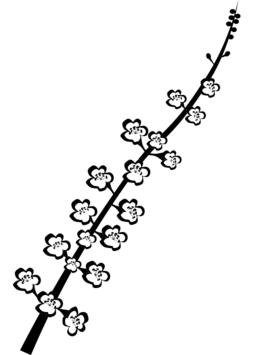
The way Poppell packages her jelly in air-tight containers, it can stay good for months or years. She offers to send me a jar when she makes the next batch, an act of kindness from a stranger. But for me, it means far more. I have never eaten seagrapes, plucked fresh from the stems like my grandmother used to. I have never slurped seagrape soup or sipped seagrape wine. I still don’t know whether Great Nanny ever made the jelly herself. I only know that a jar always sat on the counter of her mobile home. That my grandmother spread it on toast, savored it, every last bite a tart surprise.
But I never knew what it tasted like. And I longed to.
By August, the seagrapes budding in my yard in Miami had either fallen to the ground before ripening or fallen victim to hungry critters. It seemed it would be another dismal season for a harvest, and my hopes dimmed of tasting the legendary jelly. The more I chased its tart taste, the more it felt like a ghost.
Then, in late September, a package arrived at my apartment here in Gainesville. It was a small box, but heavy. My address was handwritten on an index card taped to the top. It was from Poppell. Too impatient to look for a pair of scissors, I cut the box open with a Swiss Army knife dangling from my keychain. My heart raced.
Inside was a handwritten note with a happy face: “Sent you small jars just in case you want to share.”
There they were: four jars of seagrape jelly, each one swaddled in bubble wrap. I took them out of the packaging as though I were handling precious stones. They sat on my kitchen counter just as they had in Mary’s house, in Darriel’s mobile home, all those years ago.
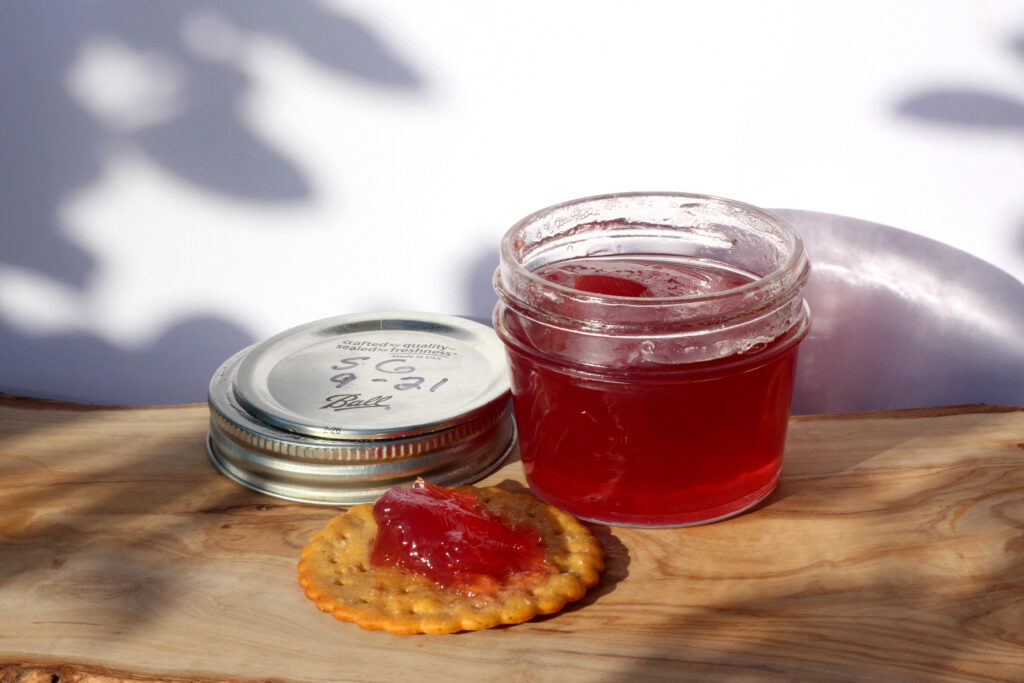
Gina Poppell sent the author four small jars of seagrape jelly in September so that she could finally get a taste. (Julia Mitchem/Atrium)
I marveled at the thought that I was finally about to taste seagrape jelly. To taste Florida.
I opened a jar. Pop! Just like the leaves of the seagrape tree, this jelly glowed in the sunlight, exposing its rich magenta hue. Already I could see my Great Nanny, the red-headed Mary Patrick, in this simple jar of jelly.
I spread a thin layer onto a wafer-thin cracker with a butterknife and lifted it to my lips. It was sweet and tangy, as I had come to expect, but surprisingly light. Refreshing. And lovely.
The taste of time I had yearned for and imagined for so long was finally an experience. Inside this jar was so much more than seagrape jelly; it was a portal to my roots.